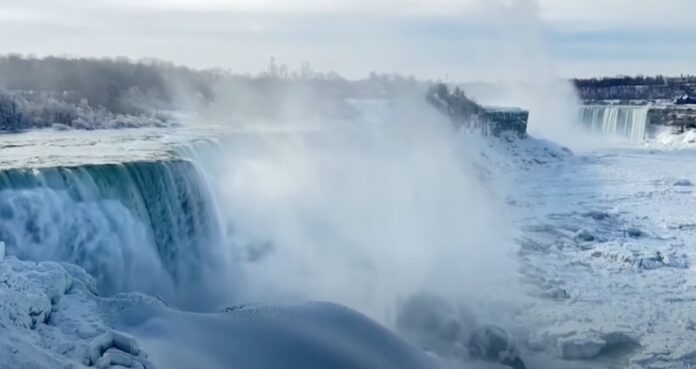Niagara Falls, one of the most iconic natural wonders in the world, is putting on a rare and chilling display. Recently, the falls have been surrounded by thick layers of ice and snow, transforming the area into a winter wonderland. This is the result of a brutal cold snap that has gripped North America. The region is experiencing the coldest winter in 13 years, but don’t worry—the falls haven’t completely frozen.
The Falls still flow, but slowly
Despite the freezing temperatures, the falls continue to flow, albeit more slowly than usual. The chilling sight is truly mesmerizing, and visitors are in for an unforgettable experience. Millions of people flock to Niagara Falls each year, but this rare winter scene is something very special.
A history of freezing
This isn’t the first time Niagara Falls has seen such freezing conditions. The falls were first recorded as having frozen in 1848, and since then, they have only fully frozen a few times. Notably, in 1911, 1912, 1917, 2014, 2015, and 2022, the falls experienced freezing temperatures that left them almost completely still.
Polar Vortex brings extreme cold
This winter, a polar vortex combined with snow and plunging temperatures has caused Niagara Falls to take on a magical, frozen appearance. The ice and snow have created a thick, frosty layer around the falls, making them appear frozen, although there’s still some movement in the water beneath. It’s a sight that’s both beautiful and eerie.
While the falls are partially frozen, it’s important to note that the movement of the water is far from stopped. Niagara Falls, which sees a staggering 168,000 m³ (5.9 million cubic feet) of water flow over its edge every minute, is still alive with energy, even though it’s slowed down a bit. The water’s movement is reduced, but the flow is still visible, adding to the eerie beauty of the scene.
Three falls, one iconic destination
Located on the border of Ontario, Canada, and New York, USA, Niagara Falls consists of three separate waterfalls. The American Falls and Bridal Veil Falls are on the U.S. side, while the largest, Horseshoe Falls, sits on the Canadian side. Despite the ice, the falls are still an awe-inspiring sight to behold.
Clipper storm causes freezing conditions
The cold front responsible for this incredible scene is due to a ‘clipper storm’ that swept southeast from Canada. The National Weather Service (NWS) issued warnings for several New York counties, including Niagara Falls, as the storm moved across the region. Clipper storms are fast-moving and bring cold air from the Canadian plains, creating the perfect conditions for freezing weather.
The illusion of a frozen waterfall
Temperatures have dropped several degrees below zero, causing fog and water spray to form a thick crust of ice around the falls. This creates the illusion of a frozen waterfall, making it appear as though the powerful cascade of water has completely stopped. It’s a rare and extraordinary phenomenon that draws visitors from all over the world.
Don’t miss this magical scene
Niagara Falls remains a must-see destination, and this winter, the falls have shown visitors an entirely new side. The snow, ice, and cold have turned the falls into a surreal masterpiece of nature. While it’s not quite a full freeze, it’s still one of the most incredible sights to witness. If you’re planning to visit, be sure to see this rare and frozen beauty before the ice melts away.




